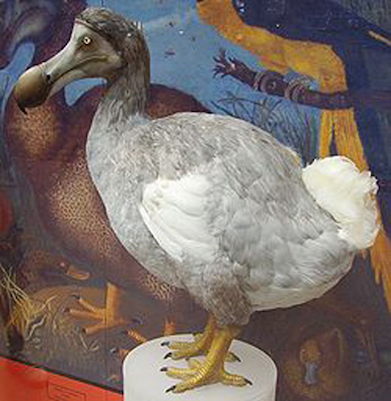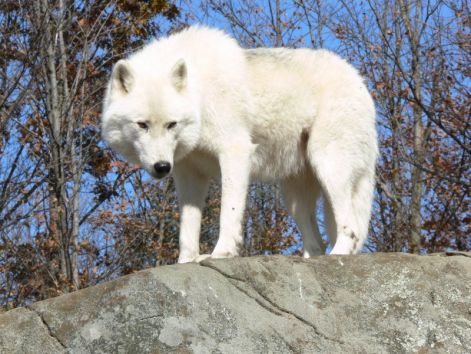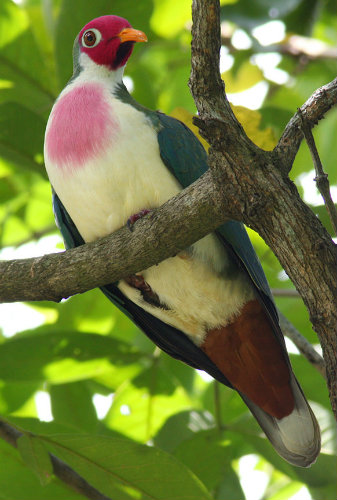Rock Fox Frequency: Common
Major Features: Hooked claws, large and bushy tail, white fur
Abilities: Excellent balance, Excellent sense of smell and hearing, Can hold their breath for up to 15 minutes, Excellent tree and mountain climbers.
Most Common In: Kalea
Summary/Abstract:
The Rock Fox is a native of Kalea. They're fiesty, sly, curious and excellent trackers. They're most commonly found near Wind Reach, scavenging for food among the mountains. They're prized for their beautiful white fur, and some people consider their tails good luck charms. These foxes have large paws, reminiscent of snow shoes, so that they can easily tread over snow without sinking in. They're also very small, not growing any larger than 35 inches long. Their tails are usually only a bit smaller than half their total length.
These foxes are commonly called "Tree Foxes" or "Wind Foxes" because of the largest population being centered near Wind Reach, and for the fact that they usually den in trees, be it a small nook or a hole at the base. They're incredible climbers, with balance rivaling that of a cat or mountain goat. In extreme circumstances, they can hold their breath for up to 15 minutes, perhaps in case of an avalanche or rock/mudslide, giving them a small amount of time to dig themselves out.
Appearance: Rock Foxes usually have thick white fur in the Winter season. Spring and Fall are when the foxes grow a thicker undercoat or lose the thick undercoat, preparing them for the coming cold or hot. They have large, bushy tails that are only a bit less than half their length, providing them warmth for cold nights. Their eyes are usually a dark colour, ranging from dark green, blue and brown to golden. Rarely, they will be a light form of blue and green.
They have large, webbed paws made for traveling over light snow, and curved claws for climbing trees. They also have very strong legs for jumping from rocky ledge to rocky ledge.
Kelvics: Kelvic of this species would usually be born in or near Wind Reach or Lhavit.
Credit goes to Nij Khalaca Frequency: Common
Major Features: A (9-inch) bill with a hooked point, decorative feathers, stout and yellowish to brown legs, with black claws. Near Flightless Bird
Abilities: Strong legs allow them to run fast, and they use their harden beaks to attack. Their wings are shorter and don't allow them to fly as normal birds do but it is possible for them to glade a short distance.
Most Common In: Kalea (Without the capacity to fly, the Khalaca could not extend its population to neighboring Regions.)
Summary:
Khalaca are native to Kalea. They are fearlessly and curious when approaching humans and other animals, which makes them easier to hunt. They make their nest on the ground surrounded by bushes. They mostly eat fruits but they are great opportunist and will also eat rodents and even insects.
Appearance: A large bird (4.4 ft) tall and weighs (32–50 lb)with brownish grey feathers, yellow to light brown feet, and a tuft of tail feathers. It has a grey or black, naked head, and a beak colored black or a dark shaded grey or brown, layered with yellow and green.
Credit goes to Aela Calder Sky Wolf Type of Creature: Sky Wolf
Frequency: Somewhat rare; 250 ~ 350 in Wind Reach and surrounding biosphere; 900 ~ 1,000 in entire Kalea region
Major Features: Distinctive coat which appears as white as snow, but is actually made up of clear, hollow strands of hair over a dense, downy undercoat; usually irises are a piercing red, though brownish and hazel variations are not entirely uncommon
Abilities: Naturally potent senses of hearing, smell, and sight (especially at night); can track a scent across two miles of snow-covered landscape, or five miles of dry, unbroken landscape (bodies of water and natural gorges greater than several metres in width will always lose scents)
Most Common In: Wind Reach and surrounding biosphere
Summary/Abstract:
Wolves are always a commonality in forested regions. The Unforgiving meets the mountainous badlands of Wind Reach to create a very unique biome, home to a vibrant host of fauna not usually found elsewhere in Kalea, let alone Mizahar at large. The Sky Wolf is one such beast, named for the striking images found of these glorious animals standing upon the peaks of mountains with nothing but the mighty sky about them.
Sky Wolves can form the same sort of packs as their various and sundry counterparts across the Wilds, with an Alpha Pair as the bonded leading unit. However, these particular wolves are also quite likely to spend their lives in solitude; it is not yet understood what drives certain members of the population away from the packs, which are usually quite large for a rarer species - up to twelve animals in one pack, which will often "rule" an entire mountainside, valley, or glade of the forest.
When on the hunt as a pack, they are surprisingly silent. There are no howls or yelps; only the quietest occasional yip from the Alpha Pair to direct the rest of the pack. They can take down much larger creatures than themselves with this tactic; it is at this point that they unleash their characteristic ghostly howls. These sorts of pack hunts typically take place at night, though in the dead of Winter, they will scour the mountainsides at all times of day to find what little game there is. Solo hunters rarely make even a sound - even if injured; they are known as the mutes of the canine world. During the winter, when snow blankets the ground and they can hardly be picked out in a landscape, this absolute silence has earned them many deadly nicknames among the local Endal Hunters of Wind Reach.
Appearance:
During three quarters of the year, the Sky Wolves boast a coat as pure and white as the finest snow. During the summer, it becomes tinged with greys, browns, and other tawny, earthy hues - a transient (and still progressing) evolutionary step towards more efficient hunting during the day in the warm season. During the midst of winter, poaching can become a problem for the species, as theirs are among the warmest natural pelts to be found without too much alteration.
Their comparatively massive size also lends to the appeal of the pelts; a healthy, sexually-mature male may stand, at the shoulder, but a few hands shy of a standard pony. However, much of the species tends to be either a bit shorter than this, or very much on the lean side, as there isn't an incredible abundance of game to feed such a large species in their biosphere. Scholars postulate that the breed is slowly shrinking, through the painstakingly slow process of natural selection, to the size of more standard feral canines. The fact that they are still as large as they are lends itself to the postulation that they are a generation or so "older" in the evolutionary timeline than most modern pack wolves. It is a subject definitely worth research.
Credit goes to Alyx Bronwyn Long Snouted Seal Type of Creature: Water Mammal
Frequency: Abundant
Major Features: Long snout, Large Ear Flaps, Split tails
Abilities: Can Hold Breath For Long Periods, Loud Trumpeting Calls
Most Common In: Thunder Bay
Summary/Abstract: The Long-Snouted Seal is a large water mammal. It lives a slow, and sedate lifestyle predominately eating on kelp and other water plants. They live in massive pods, often times living in groups of thousands. These are the largest seals in the northern regions, the biggest of males dwarfing even walruses. This species can live for up to a century. They are slow moving and docile, and most creatures leave them be simply due to their sheer size and massive numbers. Females weigh approximately a ton, with males at around a ton and a half.
Hunters of these will find their meat quite succulent and delectable. A single bull can feed several people for a long time. The seal is very blubbery, and their fat is used for everything from cooking grease, to lantern oil, to squeaky door hinges. The skin is quite thick and tough, and if treated can provide decent leather armor.
History: For centuries, the Long-Snouted Seal pods lived on the eastern shores of Storm Bay, and their numbers were in the millions. However, after the Djed Storm of 512 AV destroyed much of their natural habitat, many pods migrated westward and now occupy most of the shorelines stretching from Thunder Bay, to Denval, to Avanthal. They are now a key staple in the Endal hunting regimen and diet.
Appearance: Massive grey bodies, weighing upwards of a ton. They have long snouts that are prehensile, and can be used to gather food, or breath in air from the surface. They have large ear flaps, which serve as protection to keep small fish and parasites from getting into their extremely sensitive ears. Their tails are often split or tentacled, and varies amongst the gene pools.
Credit goes to Jaspayia Chakama Bird Type of Creature: Bird
Frequency: Rare - Only in the Cherry Grove
Major Features: Pink breast, love of Kima cherry pits
Abilities: Flight, Head changes colour when cherries are ripe, beautiful song
Most Common In: the Cherry Grove in the Unforgiving
Summary/Abstract: The Chakama Bird is a very interesting creature. Instead of eating the cherries, the bird instead feasts on the cherry pits. Its oddly shaped beak can pick out the pits without disturbing the cherry, making them easy to eat, even for small children. It has a pink breast and green outer feathers, almost blending in with the cherry trees, while the head is usually a faded blue. When the cherries are ripe, the blue head feathers are shed and within a day, new, dark pink feathers replace them. They last until the last cherry is picked, or they become overripe, when they're replaced by the blue feathers. Males and females are indistinguishable.
The Chakama's song is interesting in the fact that it seems to promote romance and romantic thoughts, making the Cherry Grove a common place for dates or picnics between lovers. The Chakama bird is often called the Lover's Bird because of their song and the fact that they mate for life. Even their eggs are a dark reddish colour with light pink speckles, matching the cherries and cherry blossoms. They lay their eggs at the same time the Kima cherry trees are flowering, and lay 1 - 3 eggs a year. Baby Chakamas are fluffy and light pink, blending in with the cherry blossoms. This further ties the Chakama birds to the existence of the Kima cherry. Some say the bird is blessed by Cheva, even.
Credit goes to Nij |
|
![]() by Phoenix on September 25th, 2011, 5:03 am
by Phoenix on September 25th, 2011, 5:03 am ![]() by Phoenix on July 7th, 2012, 2:13 am
by Phoenix on July 7th, 2012, 2:13 am 

















